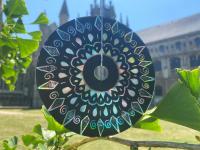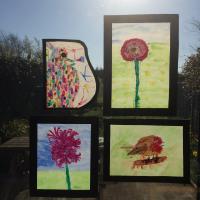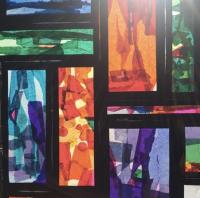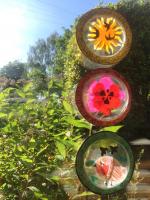Here at SGM we have created some activities inspired by our collection for young people to engage with at home.
The history of stained glass is one of story-telling, of communicating through illuminated pictures and symbols what words could not, and of framing all of this within windows. When times are hard, the stories we tell and the creativity with which we tell them are more important than ever.
In The Stained Glass Museum there is
a remarkable window by the Irish Arts and Crafts artist Harry Clarke. Colour glitters from within dark space. The people illustrated in his panels are draped in robes studded with coloured light, as if they have pulled a frosty night sky around their bodies for warmth.
Harry Clarke created these twinkling colours by using a process called Acid Etching. A thin sheet of coloured glass is layered upon clear glass to make a material known as Flashed Glass. Acid is then used to eat into the coloured layer(s), producing variations in tone and shade.
At home, we used Harry Clarke's window and technique as inspiration for our own art works, scratching magical cloaks for mysterious figures.
Magical Scratch Art - Step-by-step instructions (PDF)
Inspired by a technique called 'plating.' This is where two or more pieces of glass are over laid, to alter the way light is cast through the glass and to create new shades and textures within colour. We thought we'd have a go at using melted wax to create our own layers of colour within illuminated paper. Why not have a go at making your own melted wax picture?
Melted Wax Pictures - Step-by-step instructions (PDF)
One of our most stunning windows is
an experimental abstract stained glass panel designed by John Piper. Inspired by this, you can make your own translucent abstract artwork used coloured tissue paper. These illuminated tissue paper panels look great in your windows at home!
Illuminated Tissue Paper Windows - Step-by-step instructions (PDF)
When we think of stained glassworks we might think first of the awe-inspiring windows of churches, of iconic stories illustrated in complex arrangements on a grand scale. However, there is also a smaller, domestic tradition within the history of stained glass which we can see in the Museum's collection of Medieval Roundels. These are small circular windows, usually made of a single piece of clear glass and illustrated with glass paint, commissioned for installation in people's homes. Showing scenes from everyday life within an illustrated frame, Roundels often display themes specific to the household and family they come from, their locality and the seasonal activities of their community. Make a roundel window inspired by your everyday life, whether its things you see in the garden or on walks.
Roundels - Step-by-step instructions (PDF)
.jpg)




